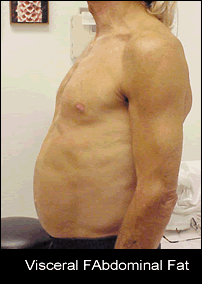 Abdominal
fat accumulation -- an aspect of lipodystrophy
syndrome -- is a concern for many HIV
positive people, both in terms of body image and cardiovascular
risk. Administration of human growth hormone has been shown
to reduce visceral adipose tissue (fat deep within the abdomen),
but it can lead to side effects including elevated blood glucose,
swelling, bone pain, and carpal tunnel syndrome.
Abdominal
fat accumulation -- an aspect of lipodystrophy
syndrome -- is a concern for many HIV
positive people, both in terms of body image and cardiovascular
risk. Administration of human growth hormone has been shown
to reduce visceral adipose tissue (fat deep within the abdomen),
but it can lead to side effects including elevated blood glucose,
swelling, bone pain, and carpal tunnel syndrome.
In
contrast to administering growth hormone directly, tesamorelin
is a growth hormone releasing factor that stimulates the pituitary
gland in the brain to secrete more growth hormone. Investigators
hypothesized that it might provide similar benefits with fewer
adverse effects, and this was supported by initial studies.
Julian Falutz from McGill University School of Medicine and colleagues
investigated the effects of tesamorelin in 404 HIV positive participants
on antiretroviral
therapy (ART) who had excess abdominal fat.
This
double-blind Phase 3 trial consisted of 2 sequential parts. During
the first 6 months, patients were randomly assigned (2:1) to receive
daily subcutaneous injections of 2 mg tesamorelin or placebo.
In the extension phase (months 6-12), participants initially receiving
tesamorelin were randomly assigned (1:1) to either continue on
the same tesamorelin regimen or switch to placebo, while patients
initially randomized to placebo switched to tesamorelin.
The
primary endpoint was changes in visceral adipose tissue, assessed
with both CT and DEXA scans. Secondary endpoints included other
body composition measurements, body image, levels of insulin-like
growth factor-1 (a protein produced in response to growth hormone
stimulation), and safety parameters.
Results
 |
Visceral
adipose tissue decreased by 10.9% (21 cm2 or about 1 kg) on
average in the tesamorelin group versus a 0.6% (1 cm2 or about
0.2 kg) decrease in the placebo group during the first 6 months
(P < 0.0001). |
 |
Trunk
fat (P < 0.001), waist circumference (P = 0.02), and waist-to-hip
ratio (P = 0.001) all improved significantly, with no changes
in limb or subcutaneous abdominal fat. |
 |
Patients
reported significantly less distress about belly appearance
in the tesamorelin group compared with the placebo group (P
= 0.02). |
 |
Physicians'
ratings of patient belly appearance also improved significantly
(P = 0.02). |
 |
Among
participants who continued on tesamorelin for 12 months, visceral
adipose tissue decreased by 17.5% (P < 0.001). |
 |
However,
the visceral adipose tissue improvements of the first 6 months
were rapidly lost in patients who switched from tesamorelin
to placebo. |
 |
Patients
receiving tesamorelin did not experience a significant decrease
in triglycerides compared with placebo (as was seen in a prior
Phase 3 study), but there was a trend in this direction. |
 |
Participants
who received tesamorelin for 12 months experienced a significant
decrease in total cholesterol. |
 |
Tesamorelin
was well-tolerated overall. |
 |
Levels
of insulin-like growth factor-1 increased significantly, but
there was no apparent change in glucose parameters. |
 |
About
4% of participants experienced hypersensitivity reactions,
which were generally mild; a few discontinued therapy prematurely
for this reason. |
Based on these findings, the study authors concluded, "Tesamorelin
reduces visceral fat by approximately 18% and improves body image
distress in HIV-infected patients with central fat accumulation.
These changes are achieved without significant side effects or
perturbation of glucose."
With
these new data, they added, "there are now consistent results
from two large Phase 3, randomized, placebo-controlled studies
to suggest that [tesamorelin] is a potentially useful clinical
strategy to selectively reduce visceral adipose tissue and improve
body image among HIV-infected patients with abdominal fat accumulation
in the context of antiretroviral therapy."
Montreal-based
developer Theratechnologies has requested approval of tesamorelin
from the U.S. Food and Drug Administration; and the agency will
told a public meeting on May 27, 2010
to discuss the topic.
Department
of Medicine, Montreal General Hospital and McGill University School
of Medicine, Montreal, Canada; Massachusetts General Hospital
and Harvard Medical School, Boston, MA.
4/2/10
Reference
J
Falutz, D Potvin, JC Mamputu, and others. Effects of Tesamorelin,
a Growth Hormone-Releasing Factor, in HIV-Infected Patients With
Abdominal Fat Accumulation: A Randomized Placebo-Controlled Trial
With a Safety Extension. Journal of Acquired Immune Deficiency
Syndromes 53(3): 311-322 (Abstract).
March 1, 2010.
